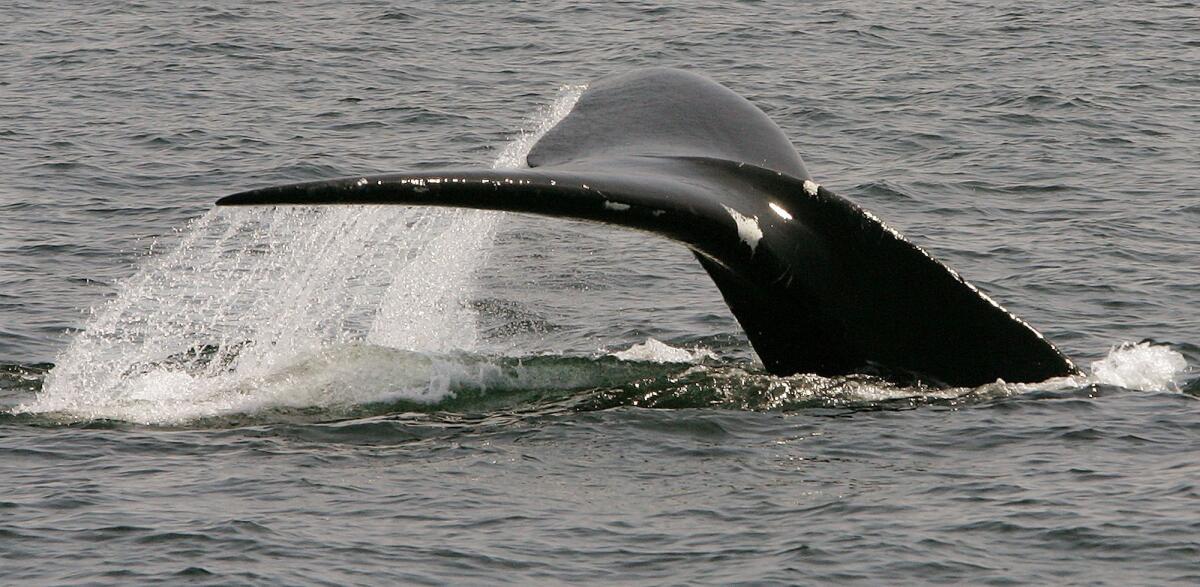New rules would make it easier to find oil — and endanger whales and dolphins

The search for offshore oil begins with a boom.
Before the oil rigs arrive and the boring begins, operators need to fire intense seismic blasts repeatedly into the ocean to find oil deposits.
For decades, environmental rules that protected whales and other marine life from this cacophony have limited the location and frequency of these blasts — preventing oil companies from exploring, and therefore operating, off much of the nation’s coasts.
Now these safeguards are quietly being dismantled.
The push to overhaul seismic survey rules has not attracted the same public attention as the Trump administration’s interest in opening coastal waters to dozens of new drilling leases or downsizing protected marine areas. But it too could have wide implications beyond enabling new oil operations.
Winding their way through Congress are two bills that supporters say would create jobs, reduce permitting delays and clear the way for naval activities and coastal restoration.
But environmentalists call them a thinly veiled oil industry wish list that would upend established protections and fast-track the permitting process for oil exploration off the Atlantic, much of Alaska and even California.
“So much legislation like this just goes under the radar,” said Rep. Jared Huffman (D-San Rafael), ranking member of the House Subcommittee on Water, Power and Oceans. “It’s a scorched earth effort right now across the whole of federal public policy to give things away to the oil and gas industry.”
The bills — dubbed the Streamlining Environmental Approvals, or SEA, Act and Strengthening the Economy with Critical Untapped Resources to Expand American Energy, or SECURE, Act — have passed committee and could head to a full vote any day.
They target core provisions of the Marine Mammal Protection Act, which regulates seismic blasts used to locate oil and gas. The noise, scientists say, can disorient and damage the hearing of whales and dolphins so badly that they lose their ability to navigate and reproduce.
The bills follow other subtle undoings that opponents have linked to prioritizing energy over conservation. President Trump, in his budget proposal, had pushed to cut all funding for the Marine Mammal Commission, an advisory group that provides scientific expertise during the review process for proposed oil activities. (Funding was restored in last month’s flurry of budget deals.)
“It’s like burning down the jail, eliminating all the laws and then shooting the court and jury,” said Richard Charter, senior fellow at the Ocean Foundation. “This is a time of setbacks, but undoing the Marine Mammal Protection Act is one of the most damaging things that Congress could possibly do right now.”
Rep. Mike Johnson (R-La.), who introduced the SEA Act, rejected assertions that his bill was driven by oil. In a statement to The Times, his office said “there’s a large campaign of misinformation against the SEA Act filled with misleading rhetoric. The SEA Act makes absolutely no changes to the protections established by the [Marine Mammal Protection Act]. Any suggestion otherwise is blatantly false.”
The changes would eliminate “cross-agency, duplicative regulations” that cause permitting delays, his spokeswoman, Ainsley Holyfield, said. They were introduced after Johnson discovered “this very issue had halted coastal restoration efforts in Louisiana and naval operations off the coast.”
Johnson’s proposals are also packaged into the SECURE Act, a broader bill by House Majority Whip Steve Scalise (R-La.) that “overhauls federal lands energy policy to promote expanded exploration, development and production of oil, gas and wind resources,” according to the House Committee on Natural Resources.
This push in Congress comes after Trump’s executive order last year, which reversed an Obama decision that had denied six companies seeking permits to conduct testing in the Atlantic. Secretary of the Interior Ryan Zinke has openly called for seismic tests to get the new data needed for energy expansion.
“Allowing this scientific pursuit enables us to safely identify and evaluate resources that belong to the American people,” Zinke said. “This will play an important role in the President’s strategy to create jobs and reduce our dependence on foreign energy resources.”
The issue has been tricky for some Republicans, particularly those representing coastal districts where offshore drilling is unpopular.
Some have spoken up. Congressman John Rutherford (R-Fla.), in a bipartisan letter last year, said seismic testing posed a direct threat to economies that rely on fishing, tourism and recreation.
“We hear from countless business owners, elected officials and residents along our coasts who recognize and reject the risks of offshore oil and gas development,” the letter, signed by dozens of Congress members, said. “It harms our coastal economies in the near term and opens the door to even greater risks from offshore oil and gas production down the road.”
Seismic surveying involves a ship firing blasts of pressurized air to create powerful sound pulses that penetrate beneath the seafloor. The sound waves that bounce back are picked up by sensors, painting a picture of potential oil deposits. Below the surface, the explosions sound like bombs going off every 10 to 15 seconds and can be heard as far as 1,500 miles, audio recordings show.
They threaten a number of species, including the blue whales that visit California’s coast and the dwindling number of right whales in the North Atlantic. Whales aren’t easy to study — they’re difficult to count, hard to track and impractical to examine (how would one even take a whale out of the water to study long-term damage to its ears?). But by analyzing their behavior, scientists have found that blasts can throw off their ability to locate food, avoid predators and find mates.
Oil and gas supporters say the research isn’t conclusive and that the best available science does not indicate that surveying damages the overall marine population.
The Marine Mammal Protection Act — signed by President Nixon in 1972, at a time when protecting marine life from overfishing and overhunting was a priority across party lines — makes it illegal to harm or kill a whale, dolphin, seal, manatee, sea otter or polar bear without a permit, even if done inadvertently.

Obtaining a seismic testing permit under the law can be a years-long process and requires companies to show their operation will have the “least practicable impact” on only “small numbers” of animals. Mitigation measures are strict and err on the side of precaution; ships have to turn off the blasts if whales are seen nearby.
The SEA Act drops the “small numbers” and “least practicable impact” conditions, and requires automatic approval of a permit if the review is not completed within 120 days. It deletes the requirement for a permit to be contained within a specific geographic region, expanding it to most anywhere off any coast.
Read more: How the SEA Act changes the MMPA »
Industry groups such as the International Assn. of Geophysical Contractors endorse the changes as much-needed modernization to a law that has “hampered [seismic surveying] by extreme environmental advocacy groups that abuse existing regulatory and litigation processes.”
Words like “negligible impact” and “small numbers” are ambiguous and have created an approval system that is biased and can delay permits for years, said the group’s president, Nikki Martin. “This is unwarranted and represents a complete bureaucratic breakdown in an otherwise straightforward process by federal agencies.”
Companies currently wishing to conduct surveys must first get a permit from the Bureau of Ocean Energy Management. If it has any potential of harming marine mammals, they must obtain additional authorization from one, often two, federal wildlife agencies.
Industry groups say seismic surveys have been safely conducted around the world for decades. Technology today is even more advanced, they say, and could point to an estimated 90 billion barrels of undiscovered oil and more than 320 trillion cubic feet of natural gas off U.S. shores.
These statements have galvanized a broad opposition, including the Natural Resources Defense Council, Oceana, Ocean Conservation Research, Greenpeace USA, Surfrider Foundation and Pacific Coast Federation of Fishermen’s Assns.
“If it’s the whales now, it’s the fish next. We are literally killing the ocean just by exploring for oil,” said Noah Oppenheim, the fishing group’s executive director. “This is really 99.9% of ocean stakeholders versus the 0.1%, the oil industry.
Rep. Alan Lowenthal (D-Long Beach), ranking member of the House Subcommittee on Energy and Mineral Resources, said the regulation currently in place is “not a broken system” and has protected marine life while also allowing some seismic testing.
From 2011 through 2016, regulators reviewed 297 applications and issued 264 seismic survey permits, according to a report by the U.S. Government Accountability Office. Most were in the Gulf of Mexico, with pressure growing to expand operations in Alaska and along the Atlantic. California has infamously fought off new oil drilling operations since 1969, when a devastating 100,000-barrel spill in Santa Barbara killed thousands of seabirds and helped spark the modern environmental movement.
“This administration is really attempting to undo all the planning and the public participation and the years of work that we did to develop this balance between energy and environmental protection,” Lowenthal said. “They want to use this as a steppingstone to have unlimited growth. That’s the real danger.”
There has been little movement on the bills since the SEA Act passed committee in January. But opponents are concerned it could be folded last-minute into this year’s military reauthorization or another must-pass bill.
Naomi Rose, who got her doctorate studying orcas and is the Animal Welfare Institute’s marine mammal scientist, says she and her colleagues around the world have long admired the U.S. for having a law that walked the walk. Many countries have “pretty words about protecting marine mammals, but no substance,” she said.
Since the Marine Mammal Protection Act was enacted 46 years ago, no marine mammal has gone extinct in U.S. waters.
But in the last year, so many longstanding rules have been challenged.
“Things are moving fast. It’s really dizzying. It’s really, really scary,” she said. “I’ve been doing this for 25 years, and I’ve just never seen anything like this.”
Interested in coastal issues? Follow @RosannaXia on Twitter.
More to Read
Sign up for Essential California
The most important California stories and recommendations in your inbox every morning.
You may occasionally receive promotional content from the Los Angeles Times.











